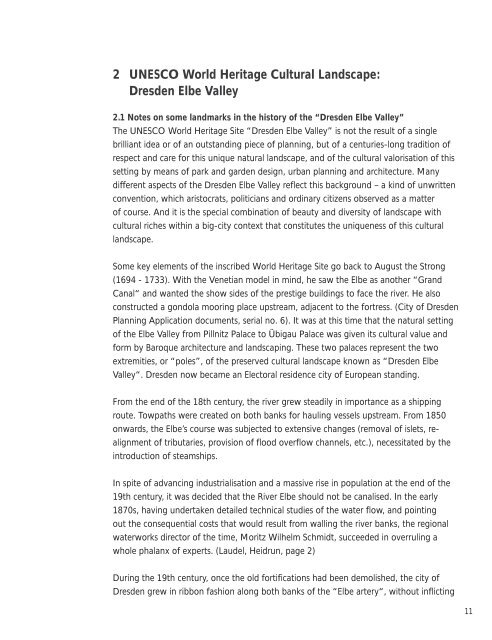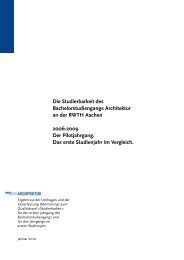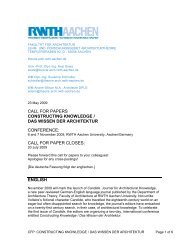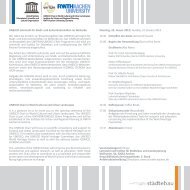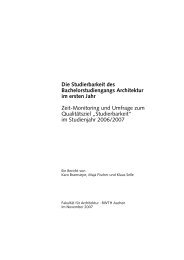Gutachten Dresden_englisch_dritte f.indd - Fakultät für Architektur ...
Gutachten Dresden_englisch_dritte f.indd - Fakultät für Architektur ...
Gutachten Dresden_englisch_dritte f.indd - Fakultät für Architektur ...
Create successful ePaper yourself
Turn your PDF publications into a flip-book with our unique Google optimized e-Paper software.
2 UNESCO World Heritage Cultural Landscape:<br />
<strong>Dresden</strong> Elbe Valley<br />
2.1 Notes on some landmarks in the history of the “<strong>Dresden</strong> Elbe Valley”<br />
The UNESCO World Heritage Site “<strong>Dresden</strong> Elbe Valley” is not the result of a single<br />
brilliant idea or of an outstanding piece of planning, but of a centuries-long tradition of<br />
respect and care for this unique natural landscape, and of the cultural valorisation of this<br />
setting by means of park and garden design, urban planning and architecture. Many<br />
different aspects of the <strong>Dresden</strong> Elbe Valley reflect this background – a kind of unwritten<br />
convention, which aristocrats, politicians and ordinary citizens observed as a matter<br />
of course. And it is the special combination of beauty and diversity of landscape with<br />
cultural riches within a big-city context that constitutes the uniqueness of this cultural<br />
landscape.<br />
Some key elements of the inscribed World Heritage Site go back to August the Strong<br />
(1694 - 1733). With the Venetian model in mind, he saw the Elbe as another “Grand<br />
Canal“ and wanted the show sides of the prestige buildings to face the river. He also<br />
constructed a gondola mooring place upstream, adjacent to the fortress. (City of <strong>Dresden</strong><br />
Planning Application documents, serial no. 6). It was at this time that the natural setting<br />
of the Elbe Valley from Pillnitz Palace to Übigau Palace was given its cultural value and<br />
form by Baroque architecture and landscaping. These two palaces represent the two<br />
extremities, or “poles”, of the preserved cultural landscape known as “<strong>Dresden</strong> Elbe<br />
Valley“. <strong>Dresden</strong> now became an Electoral residence city of European standing.<br />
From the end of the 18th century, the river grew steadily in importance as a shipping<br />
route. Towpaths were created on both banks for hauling vessels upstream. From 1850<br />
onwards, the Elbe’s course was subjected to extensive changes (removal of islets, re-<br />
alignment of tributaries, provision of flood overflow channels, etc.), necessitated by the<br />
introduction of steamships.<br />
In spite of advancing industrialisation and a massive rise in population at the end of the<br />
19th century, it was decided that the River Elbe should not be canalised. In the early<br />
1870s, having undertaken detailed technical studies of the water flow, and pointing<br />
out the consequential costs that would result from walling the river banks, the regional<br />
waterworks director of the time, Moritz Wilhelm Schmidt, succeeded in overruling a<br />
whole phalanx of experts. (Laudel, Heidrun, page 2)<br />
During the 19th century, once the old fortifications had been demolished, the city of<br />
<strong>Dresden</strong> grew in ribbon fashion along both banks of the “Elbe artery“, without inflicting<br />
11


